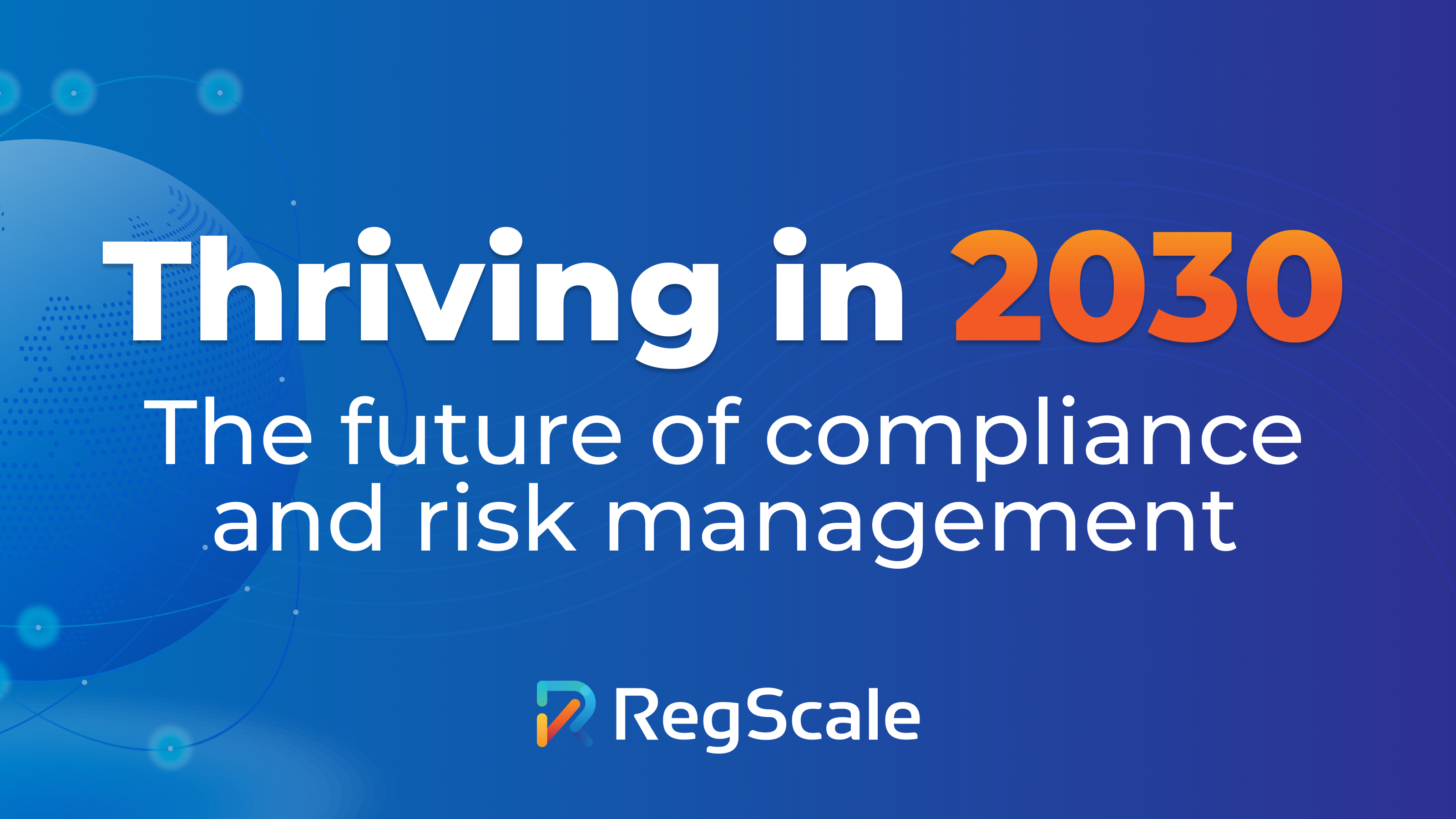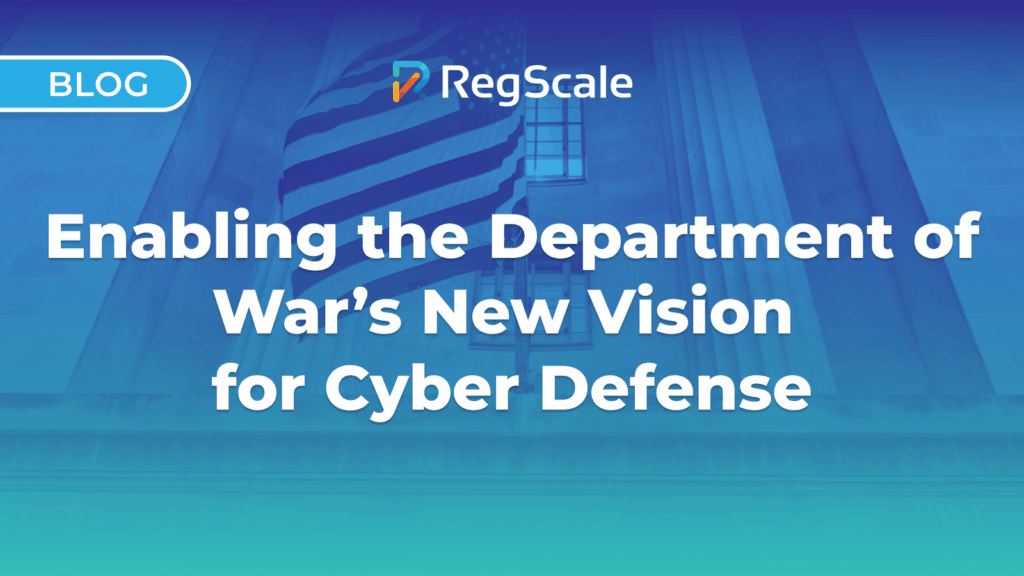Thriving in 2030: The future of compliance and risk management

RegScale CEO Travis Howerton recently contributed an insightful byline to Security Magazine, “Thriving in 2030: The Future of Compliance and Risk Management.” This article details the future landscape of compliance and risk management as we approach 2030. It delves into the significant technological and regulatory changes that organizations need to prepare for to ensure resilient compliance and risk management strategies.
The evolution of compliance and risk management
Emphasizing the rapid evolution of technology, Howerton highlights the rise of cloud-native applications and ephemeral technologies. These advancements promise improved scalability and efficiency but also introduce new compliance and risk management challenges. Traditional methods of understanding IT infrastructure and data location are becoming obsolete, making it crucial for organizations to adopt modern approaches to track assets, enforce access controls, and ensure data security.
Three key strategies for advanced compliance in 2030
To navigate this evolving security, risk, and, compliance landscape, Howerton outlines three essential strategies:
1. Implement Continuous Controls Monitoring (CCM) and compliance as code
Adopting Continuous Controls Monitoring (CCM) automates the oversight and validation of internal controls, providing real-time assessments and insights. By embedding compliance requirements into software development and operational workflows through compliance as code, organizations can streamline efforts, reduce manual interventions, and enhance efficiency.
With cloud-native applications and ephemeral technologies on the rise, traditional compliance approaches may no longer suffice. It’s crucial to know what is running and where at any time to meet compliance and security requirements. CCM offers real-time assessment and reporting of security controls, facilitating compliance with regulatory mandates like cyber incident disclosure requirements.
Compliance as code (CAC) is the future of compliance management. By automating requirements using machine-readable control catalogs and baselines, CAC eliminates manual tasks and integrates compliance into workflows, ensuring continuous adherence even in dynamic environments. Supported by NIST’s Open Security Controls Assessment Language (OSCAL), CAC helps automate processes, maintain audit trails, and demonstrate regulatory compliance.
Advanced CCM solutions offer key benefits:
- Automated evidence collection: Reduces time and effort for audit preparations.
- Enhanced data management: Centralizes compliance data, simplifying retrieval and visualization.
- Advanced Reporting Capabilities: Generates detailed reports to demonstrate compliance with regulatory standards.
These features show how CCM and compliance as code can revolutionize compliance and risk management, making them more proactive, efficient, and seamlessly integrated into modern technological environments. This approach not only maintains compliance but also enhances cyber security posture, ensuring readiness for the challenges of 2030 and beyond.Learn more about how compliance as code can transform your compliance strategy by visiting our Compliance as Code page.
2. Generate on-demand, audit-ready documentation
Emphasizing the rapid evolution of technology, Howerton highlights the rise of cloud-native applications and ephemeral technologies. These advancements promise improved scalability and efficiency but also introduce new compliance and risk management challenges. Traditional methods of understanding IT infrastructure and data location are becoming obsolete, making it crucial for organizations to adopt modern approaches to tracking assets, enforcing access controls, and ensuring data security.
In this context, leveraging Continuous Controls Monitoring (CCM) becomes essential. CCM enables organizations to proactively manage and monitor IT risks and compliance issues in near real-time, providing a strategic, real-time, and proactive approach.
Key benefits of CCM include:
- Audit efficiency: Reduces audit preparation efforts by up to 60%, minimizing the manual burden and ensuring always audit-ready documentation.
- Cost reduction: Lowers compliance-related costs by 30% through automation and streamlined processes.
- Real-time risk management: Maintains continuous oversight with real-time monitoring, allowing for prompt risk mitigation.
- Enhanced data management: Centralizes compliance data, simplifying the visualization of relationships and improving data retrieval and exchange.
These advantages demonstrate how adopting advanced CCM solutions can transform compliance and risk management, making them more efficient, cost-effective, and adaptive to the evolving technological landscape. For organizations aiming to succeed in this rapidly changing environment, embracing these modern compliance strategies is crucial.
3. Create a unified security, risk, and compliance strategy
Security, risk, and compliance activities have traditionally functioned independently from one another. Howerton recommends a unified approach that consolidates these areas into a cohesive framework. This integration enhances security measures, strengthens risk management, and simplifies compliance processes.
Adopting a unified security, risk, and compliance strategy involves:
- Streamlined Compliance Assurance: Ensuring organizations are always audit-ready by reducing the burden of audit preparation and maintaining continuous compliance through automated processes.
- Improved Risk Management: Continuously monitoring controls for effectiveness and compliance transforms risk management from a periodic, reactive process to a constant, proactive guard against potential vulnerabilities.
- Flexible Deployment Models: Offering various deployment options, including SaaS, on-premises, and within CI/CD pipelines, to cater to different organizational needs and IT strategies.
- Comprehensive Risk Approach: Managing various types of risks, including audit risk, IT/cyber risk, asset risk, financial risk, enterprise risk, third-party risk, and opportunity risk, to provide a holistic view and management of risks across the organization.
Integrating security, risk, and compliance into a unified strategy not only enhances operational efficiency but also ensures robust protection and adherence to regulatory standards. This comprehensive approach is essential for organizations looking to thrive in today’s dynamic regulatory environment.
Preparing for increased regulatory burden
Security, risk, and compliance activities have traditionally operated in silos, leading to inefficiencies and limited visibility into risks across the organization. Howerton recommends a unified approach that consolidates these areas into a cohesive framework. By defining security priorities, risk tolerance levels, and compliance requirements, organizations can set clear goals and integrate these efforts to improve both their security posture and risk management capabilities.
To manage these demands effectively, leveraging Continuous Controls Monitoring (CCM) and compliance as code is crucial. These technologies automate compliance processes, provide real-time assessment and reporting, and reduce manual interventions. This not only streamlines compliance assurance and enhances risk management, but also ensures continuous adherence to regulatory standards.
By fostering a culture of communication and collaboration across security, risk, and compliance teams, organizations can create a more efficient and resilient framework. This integrated approach not only addresses current regulatory demands but also prepares organizations for future challenges.
The role of AI in compliance
With technology advancements occurring at a seemingly break-neck pace, Howerton predicts that artificial intelligence (AI) will play a significant role in the future of security, compliance, and risk management. AI technologies can automate tedious manual tasks, allowing compliance professionals to focus on strategic decision-making. By leveraging AI, organizations can supercharge their staff and enhance their ability to detect and respond to compliance risks more quickly and accurately. AI can also provide predictive analytics, helping to foresee potential compliance issues before they arise, thereby proactively mitigating risks. This integration of AI into compliance processes not only improves efficiency but also significantly boosts the effectiveness of compliance programs.
Unlock future compliance strategies
For a deeper dive into these strategies and insights, RegScale invites you to download our comprehensive white paper, “GRC in 2030: A CISO Survival Guide.”. This resource provides detailed guidance on how organizations can prepare their compliance and risk management programs for the future, leveraging technologies like CCM, compliance as code, and AI-driven automation.
By embracing these strategies and technologies, organizations can navigate the complex landscape of compliance and risk management, ensuring they are well-prepared for the challenges of 2030 and beyond.
Ready to get started?
Choose the path that is right for you!
Skip the line
My organization doesn’t have GRC tools yet and I am ready to start automating my compliance with continuous monitoring pipelines now.
Supercharge
My organization already has legacy compliance software, but I want to automate many of the manual processes that feed it.
